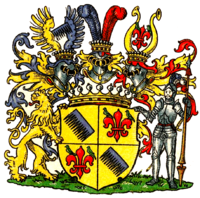Joseph Karl Anrep-Elmpt


Joseph Karl Anrep-Elmpt ( Russian Иосиф Романович Анреп-Эльмпт * January 26 jul. / 6. February 1796 greg. , † July 4 jul. / 16th July 1860 greg. In St. Petersburg ) was an Imperial Russian officer , last General of the Cavalry .
Life
Karl Joseph Anrep-Elmpt came from the German-Baltic noble family Anrep . His parents were the imperial Russian lieutenant general and Livonian district administrator Reinhold von Anrep (1760-1807) and Caroline von Anrep (1757-1824).
Anrep began his career in the army with the page corps in St. Petersburg and eventually became a chamber page before joining the Chevalier Guard Regiment in 1815 as a cornet . In 1818 he became an adjutant to General von Diebitsch . In 1826 he was promoted to colonel and commander of the Charkov- Uhlan regiment. He took part in the Turkish war in 1828 and 1829 and was seriously wounded during the unsuccessful siege of the Silistra fortress . Probably for this he received the Order of St. George 4th Class in 1830 and was promoted to major general in 1831 . In the Polish War he served as brigade commander and was awarded the Order of St. Anne, 1st class with a golden saber of honor for his work in the storming of Warsaw .
After a break from active service, he was employed as head of the Džary-Belakany district from 1839 to 1841 and as head of the Black Sea coastline from 1841 to 1843 . In 1842 he became adjutant general and was promoted to lieutenant general in 1844. In 1849 he was in the field as a division commander in Hungary and received the Alexander Nevsky Order for his services . From 1850 to 1855 he was in command of the 1st Light Guard Cavalry Division and in 1858 was part of the Russian Corps in Wallachia . In 1860 he was promoted for the last time, to general of the cavalry .
Anrep had owned the Livonian estates Kerstenhof , Murrikatz and Willust since 1830 , and in 1833 by marriage, Burgau in the Rhineland .
1853 Anrep including crest and name association was with his wife by Tsar Nicholas I in the Russian count conditions raised . In 1854 he received the Courland Indigenous School , so he was enrolled on the knight's bank .
family
Anrep married in Riga in 1833 with Countess Cäcilie Philippine von Elmpt (1812-1892), court master of Tsarina Alexandra , daughter of Lieutenant General Philipp von Elmpt (1763-1818) and the chief chamberlain of Grand Duchess Helena Pavlovna , Anna Magdalena von Baranoff . Since his wife was the last of her sex, the directing imperial Russian senate allowed to carry out a name and coat of arms association . On July 1, 1853, this act was approved by Tsar Nicholas I. The agnatic line of the couple led from then on the count's name from Anrep-Elmpt, but went out in the male line in 1888 in the following generation.
Children:
- Reinhold (1834–1888), decided on both the Anrep-Elmpt family and the Anrep -Haus Lauenhof-Kerstenshof
- ⚭I Leontine von Tenner (1838–1910), daughter of the Imperial Russian infantry general Carl Friedrich Tenner
- ⚭II Freiin Helene von Stackelberg adH Thomel (1845–1930)
- Alexandrine (1837-1920)
- ⚭ 1861 Freiherr Alexander von Budberg , lord of the Brick-Poniemon
- Marie (1843-1925)
- ⚭I 1872 Count Heinrich von Keyserling-Rautenburg (1831–1874)
- ⚭II Count Spiridion Lusi
- ⚭III 1903 Antonio Frosini, Marchese di Albinea († 1925)
- Joseph (1844-1880)
- Cäcilie (1847-1928)
- ⚭ 1863 Count Hugo von Keyserlingk-Rautenburg (1839–1904)
literature
- Astaf von Transehe-Roseneck (edit.): Genealogical Manual of the Livonian Knighthood , Volume 1, Görlitz 1929, p. 9
Web links
- Baltic Historical Commission (ed.): Entry on Joseph Karl Anrep-Elmpt. In: BBLD - Baltic Biographical Lexicon digital
Individual evidence
- ^ Ernst Heinrich Kneschke : German count houses of the present: in heraldic, historical and genealogical relation. Volume 3, Leipzig 1854, p. 98
- ↑ Carola L. Gottzmann and Petra Hörner: Lexicon of German-Language Literature of the Baltic States and St. Petersburg , Berlin 2007, p. 680
| personal data | |
|---|---|
| SURNAME | Anrep-Elmpt, Joseph Karl |
| ALTERNATIVE NAMES | Анреп-Эльмпт, Иосиф Романович (Russian) |
| BRIEF DESCRIPTION | imperial Russian adjutant general |
| DATE OF BIRTH | February 6, 1796 |
| DATE OF DEATH | July 16, 1860 |
| Place of death | St. Petersburg |

